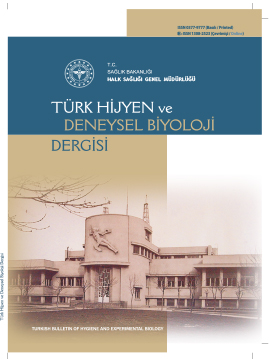
Bu eser Creative Commons Alıntı-GayriTicari-Türetilemez 4.0 Uluslararası Lisansı ile lisanslanmıştır.













Volume: 80 Issue: 2 - 2023
| FULL JOURNAL | |
| 1. | TBHEB 2023-2 Vol 80 Full Printed Journal Utku ERCÖMERT doi: 10.5505/TurkHijyen.2023.72693 Pages 134 - 245 Abstract | |
| RESEARCH ARTICLE | |
| 2. | Investigation of the effect of Moringa oleifera extract on fibroblast degeneration caused by disinfectants used at different pH levels in the COVID-19 pandemic Yeşim YENİ, Sıdıka GENÇ, Ahmet HACIMÜFTÜOĞLU, Ali TAGHİZADEHGHALEHJOUGHİ doi: 10.5505/TurkHijyen.2023.09069 Pages 135 - 144 INTRODUCTION: The rapid spread of the coronavirus disease, which started in 2019, has caused it to become a global epidemic. To control the spread of the coronavirus epidemic, some prevention procedures such as wearing face masks, maintaining social distance and hand hygiene have begun to be implemented. Accordingly, the use of disinfectants in public places such as transportation and shopping has gained importance. However, studies have shown that long-term use of disinfectants with different pH values triggers the development of itching, redness, urticaria and even allergic rhinitis. The low saturated fatty acids and high amounts of olive oil found in Moringa oleifera (MO) leaves, flowers, green beans, seeds and seed oil are excellent sources of nutrients and vitamins. Today, MO is used in a variety of skin care applications. In addition, the leaf of MO also has antiretroviral, antimicrobial, antioxidant, antifungal properties. The aim of this study is to prevent toxicity against different pH changes by using MO plant. METHODS: In our study, a human fibroblast cell line was grown under the conditions specified by the manufacturer and inoculated into 96 well plates and a culture medium with different pH (5.0, 6.0, 7.0 and 8.0) was prepared and different doses of MO (20, 40, 80 and 160 μg/ml) were prepared. It is planned to eliminate the toxicity caused by using it for 24 hours. At the end of the study, 3-(4,5-dimethylthiazol-2-yl)-2,5-diphenyl-2H-tetrazolium bromide (MTT), Glutathione Reductase (GR), and Lactate Dehydrogenase (LDH) tests were used. RESULTS: According to the results of our study, cell viability increased from %69 to %89 compared to positive control at pH 5.0. The vitality that decreased to %80 at pH 6.0 increased to 143 as a result of the application of the highest concentration of MO (160 μg/ml). While it increased from %79 to %115 at pH 7.0, the damage received by fibroblast cells at pH 8.0 was determined to be high (viability rate %66), and it was observed that this toxicity was removed, and the vitality was increased up to %93. All results were statistically evaluated and found to be significant (P<0.05 and P<0.01). DISCUSSION AND CONCLUSION: Considering the results obtained, MO is recommended to be used at doses of 80 and 160 μg/ml, as it has a protective effect. The LDH and GR results show a correlation with MTT. |
| 3. | How COVID-19-related national lockdown affected daily life activities and physical pain status? A sample from the Turkish Republic of Northern Cyprus Taygun DAYI, Müjgan ÖZTÜRK, Melis BAĞKUR doi: 10.5505/TurkHijyen.2023.68366 Pages 145 - 158 INTRODUCTION: After COVID-19 has been defined as a pandemic, it was decided on national lockdowns in most countries. The COVID-19-related lockdown affected both people’s physical, social and mental health and also the public economy negatively. In this study, it was aimed to evaluate the effects of COVID-19, during and after pandemic related lockdown, on daily life activities, economic anxiety, and pain status in the Turkish Republic of Northern Cyprus. METHODS: Data was collected via an online questionnaire and voluntary people (n: 307) who were on the island between March-May-2020 participated. Nutritional behaviors (shopping, disinfection of packaged foods, preparation of new recipes, appetite), physical activity behaviors, sedentary activities (e.g. screen time) and physical pain status of participants during and after lockdown were questioned. RESULTS: Most of the participants’ physical activity levels decreased and sedentary behaviors increased during the lockdown. Although they slept more (7,69±1.47 vs 7.16±1.04) (p<0.001), sleep quality was declared lower (3.28±1.12 vs 3.45±1.00) (p: 0.030). New recipes were tried but most of the participants do not continue to cook these recipes after lockdown. Most of the participants (78.2%) had an increased duration of time in front of the screen on the internet during the lockdown and decreased physical activity and step count (56.7% and 62.9% respectively). Approximately, half of these participants declared a significant decrease in their screen time after the lockdown (p< 0.001). Moreover, both the alteration of body weight and increased screen time increased relapsing pain (p: 0.034, p: 0.024) and the most common focus of pain during lockdown was found as the neck area for each pain status. DISCUSSION AND CONCLUSION: In addition to health measures taken during pandemics, official bodies should also be prepared to cope with the changes in daily life activities which can lead to chronic diseases. |
| 4. | The example of Ankara in pandemic communications “COVID-19 Crisis Centers” Asiye Çiğdem ŞİMŞEK, Mustafa Sırrı KOTANOĞLU, Hasan GÜL, Deniz ÇAKMAK, Seher MUSAONBAŞIOĞLU, Yunus Emre BULUT, Ebru AYDAL, Hasan IRMAK, Zülfikar AKELMA doi: 10.5505/TurkHijyen.2023.54280 Pages 159 - 170 INTRODUCTION: After the World Health Organization (WHO) declared the new coronavirus epidemic as the “COVID-19 pandemic” on March 11, 2020; the COVID-19 Call Center was established on March 15, 2020 within the Ankara Provincial Health Directorate. It was aimed to evaluate the works of the COVID-19 Call Center, which was one of the call centers established to answer questions from our citizens and to serve 24 hours a day, 7 days a week, in this study. METHODS: The data of our descriptive study was collected between January 01, 2021 and December 31, 2021, and statistical evaluation, number and percentage distributions were made with Google Drive software reports. RESULTS: Information about COVID-19 vaccines was requested in 5% of the calls incoming to the COVID-19 Call Center, 34% of the callers were contacts and 39% were positive cases. 25.39% of the calls were for PCR testing, 20.45% for information about the disease and 15.04% for information about the quarantine process. 18.514 cases (2.51%) whose conditions evaluated as emergency were referred to the hospitals by ambulance. DISCUSSION AND CONCLUSION: It is necessary to gain the trust of the public by transmitting accurate, understandable and easily accessible information for epidemic management. The Ankara Provincial Health Directorate COVID-19 Call Center, which was created for this purpose, continues to contribute to the acquisition of accurate information by means of verbal communication by reaching the 7/24 at any time of the day. |
| 5. | Health promotion model of COVID-19 prevention and control behavior: A mixed methods study Widana PRIMANINGTYAS, Endang SUTISNA SULAEMAN, Heni HASTUTI, Anak Agung Alit Kirti Estuti Narendra PUTRİ, Abdul RAHMAN, Slamet RIYADI doi: 10.5505/TurkHijyen.2023.53896 Pages 171 - 182 INTRODUCTION: Lack of health promotion to eradicate coronavirus disease 2019 (COVID-19) remains a major issue in 2021. COVID-19 cases in Indonesia are the highest in Southeast Asia. Effective promotion models for prevention and control of COVID-19 (PCCOVID-19) in all areas are needed. This study aims to examine the selected health promotion models for preventing COVID-19 escalation. METHODS: This study used a mixed methods approach, including a survey to collect quantitative data and focus group discussions (FGDs) to elaborate on qualitative data. The study was conducted between July and September 2021, which included 166 respondents living in Boyolali-Central Java, Indonesia. Several questions used in the survey and FGDs were designed based on the health belief model (HBM), social cognitive theory (SCT), and social support model (SSM). RESULTS: Approximately 92% of the survey participants completed the online questionnaires, while eight informants joined the FGD. The whole path analysis model described 53% of the variables that correlated with PCCOVID-19 behavior. The available FGD data indicated that HBM at the individual level is crucial for COVID-19 task force and healthcare workers for promoting a protective behavior during the pandemic. SCT can be applied to understand the intention of PCCOVID-19 behavior at an interpersonal level. At the community level, social support plays an important role in providing assurance to enhance the PCCOVID-19 behavior. DISCUSSION AND CONCLUSION: Applying the HBM, SCT, and SSM constructs, can optimize the PCCOVID-19 behavior. Perceived susceptibility, observational learning, outcome expectations, instrumental and emotional support were directly and significantly correlated with PCCOVID-19 behavior, whereas perceived susceptibility and barriers had an indirect significant correlation with PCCOVID-19 behavior through cues to action variables. These findings can be used by healthcare workers, especially COVID-19 task force to develop health promotion methods and interventions to enhance the PCCOVID-19 behavior. |
| 6. | The possible role of the poly(ADP-ribose) polymerase pathway in nicotine-induced nephrotoxicity in mice Selin HAZIR doi: 10.5505/TurkHijyen.2023.32767 Pages 183 - 190 INTRODUCTION: Smoking is one of the most important preventable cause of death that threatens public health and is widely used all over the world. Nicotine is an important toxic component in tobacco and contributes to the pathogenesis of many chronic diseases. The aim of this study is to investigate the possible role of kidney functions, oxidative DNA damage, apoptosis and PARP pathway in nicotine-induced nephrotoxicity. METHODS: 24 male C57BL6J mice were divided into control, saline and nicotine groups. Nicotine group mice were injected subcutaneously with nicotine at a dose of 3 mg/kg twice a day for 14 days. The saline group was injected with physiological saline. No procedure was performed to the control group. At the end of the experiment, cardiac blood samples and bilateral kidney tissues were isolated. The levels of 8-OHdG and cotinine were measured in serum by ELISA method. Hematoxylin - eosin staining was performed to right kidney tissues for morphological evaluation. Caspase-3 and PARP-1 gene expression levels were determined by real-time quantitative polymerase chain reaction method in left kidneys. RESULTS: Body and kidney weights decreased significantly in nicotine group (P<0.05). Serum 8-OHdG level was significantly increased in nicotine group (P<0.05). Serum cotinine level was measured as 303.11±0.3 ng/ml in nicotine group. Glomerular diameter and mesangial matrix were increased in nicotine group. In addition, tubular dilatation was observed in nicotine group. Caspase-3 and PARP-1 gene expression levels were significantly increased in the nicotine group compared to the control and saline groups (P<0.05). DISCUSSION AND CONCLUSION: In conclusion, it was determined that nicotine exposure increased oxidative DNA damage in kidney tissue and induced intracellular apoptosis and PARP pathway. |
| 7. | Investigation of Demodex and superficial flora in patients with Rosacea Özlem AYTAÇ, Neşe GÖÇER GÜROK, Feray Ferda ŞENOL, Zülal AŞÇI TORAMAN, Savaş ÖZTÜRK doi: 10.5505/TurkHijyen.2023.56667 Pages 191 - 200 INTRODUCTION: In our study, it was aimed to investigate the presence of Demodex spp. and bacterial population in rosacea patients and to contribute to the treatment process of the disease. METHODS: In the study, 90 patients who applied to Elazig Fethi Sekin City Hospital Dermatology policlinic were diagnosed with rosacea were included. Samples were taken from rosacea patients with active lesions by standard superficial skin biopsy (SSSB). Aerobic and anaerobic cultures were performed bacteriologically on the samples taken from the simultaneous lesion. Microorganisms grown in culture were identified by Matrix assisted laser desorption ionization time of flight mass spectrometry (MALDI-TOF MS, Bruker, Germany) mass spectrometry. RESULTS: A total of 90 patients, 74 (82.2%) females and 16 (17.8%) males, were included in the study. Demodex positivity was observed in 63 of them (70%). Of the patients, 65 (72.2%) were ETR and 25 (27.8%) were PPR patients. The growth rate of Staphylococcus epidermidis (S. epidermidis) was found to be significantly higher in ETR patients (29.2%) than in PPR patients (8%). Staphylococcus aureus (S. aureus) growth rate was found to be significantly lower in ETR patients (30.8%) than in PPR patients (56%) (p<0.05). However, there was no significant difference between the growth status of B. cereus (p=1,000), B. pumilus (p=1,000), E. coli (p=0,435) and S. pneumonia (p=0,557) bacteria according to rosacea clinical subtypes of the patients. B. cereus growth in Demodex positive ETR patients was found to be significantly higher than in PPR patients (p<0.05). DISCUSSION AND CONCLUSION: According to the data we obtained in our study, we think that Bacillus species (such as B. cereus, B. pumilus), which were not emphasized much in previous studies, and S. aureus may contribute to the development of clinical subtypes of the disease. As a result; Considering this situation in the treatment of Demodex, it will be beneficial to plan the clinical symptoms of the disease. |
| 8. | The role of Brucella abortus strains in the abortion etiology of domestic ruminants in the Cukurova region, Turkey and molecular epidemiological characteristics Süleyman ASLAN, Tülay KANDEMİR, Nur Sima UPRAK, Toğrul NAĞIYEV doi: 10.5505/TurkHijyen.2023.35033 Pages 201 - 212 INTRODUCTION: Brucellosis caused by bacteria of the Brucella genus is a globally important zoonotic disease. B. abortus, which usually causes abortion and infertility in cows, can cross-infect ruminants and also cause chronic disease in humans. Controlling outbreaks in ruminants is essential to prevent economic losses and human disease due to bovine brucellosis. Since classical phenotypic methods alone are insufficient in monitoring epidemic strains of B. abortus, genotypic surveillance has become crucial today. We aimed to determine the role of B. abortus strains in the abortion etiology of domestic ruminants in the Cukurova region, Türkiye, reveal the phylogenetic relationships of the isolated strains using molecular methods and examine the availability of these methods in this field. METHODS: One hundred eighteen abortion samples were included in the study. Following the isolation and identification of B. abortus, the clonal relationship between these isolates was investigated by Pulse-Field Gel Electrophoresis (PFGE) and Multi-Locus Variable Number Tandem Repeat Analysis (MLVA) methods. RESULTS: B. abortus was detected in 17 (14.4%) of 118 abortion cases examined. The distribution of B. abortus isolates among cattle, goats and sheep was 72.2% (13/18), 5.9% (3/51) and 2.0% (1/49), respectively. The 14 (82.4%) of B. abortus isolates were biovar 3. A single cluster and four pulsotypes (HGDI=0.5662) were determined by the PFGE, five types (HGDI=0.6838) by the MLVA-16, and six genotypes (HGDI=0.7132) by evaluating these two methods together. Genotype 1, which consists of nine (52.9%) isolates, six obtained from cattle and three from goats, was predominant. DISCUSSION AND CONCLUSION: Although the discriminative powers of the PFGE and MLVA methods were not high enough when a small number of samples were examined, the discriminatory power of MLVA-16 was determined to be higher than PFGE in determining the regionally predominant B. abortus genotypes. Moreover, the use of both together was even more effective. Since using the two methods together in epidemiological studies requires additional costs and effort, it was concluded that the predominant genotypes could be determined, especially during epidemic periods and evaluated in vaccine studies. Additional examination of human clinical specimens in epidemic areas will further strengthen the results to be obtained. Thus, our study will provide essential data for the studies to be performed in order to control brucellosis outbreaks, which constitute a serious public health problem. |
| REVIEW | |
| 9. | Toxoplasma gondii studies on cats in Turkey Banuçiçek YÜCESAN doi: 10.5505/TurkHijyen.2023.95871 Pages 213 - 220 Toxoplasma gondii (T. gondii) is an intracellular protozoan parasite in the Apicomplexa phylum that can be widely seen all over the world. In this study was performed to evaluate the study areas, test methods, positivity rates, regional results and studies. In this study, Pubmed, Google Scholar, Web of Science, Science Direct, Scopus and National Thesis Center databases were examined until 01.04.2022 and T. gondii studies in cats in Turkey were documented. Microscopic, serological [SFDT (Sabin Feldman Dye test), IHA (Indirect hemagglutination test), IFA (Indirect fluorescent antibody test), ELISA (Enzyme lynked immunosorbent assay), CFT (Complement fixation test)] and molecular analysis methods in cats in Turkey (PCR = Polymerized Chain Reaction) was used. 21 publications were identified in this meta-analysis. It has been determined that toxoplasmosis studies in cats are mostly seroprevalence studies (16/21). Studies were carried out in Eastern Anatolia (5/21) and Mediterranean Region (4/21), mostly in Central Anatolia (11/21) and Aegean Region (4/21). No study was found in the Marmara, Black Sea and Southeastern Anatolia Regions. It was determined that the regional distributions were Central Anatolia Region (52.32%), Eastern Anatolia Region (45%), Aegean Region (36.33%) and Mediterranean Region (22.2%). The positivity rate for cats in Turkey is 41.5%. Rates in prevalence studies in final host cats indicate that infection is still an important public health concern. For this purpose, it is thought that researches and preventive activities should be increased, especially in areas where no studies have been made. |
| 10. | Hygiene practices in catering establishments and COVID-19 precautions Ayşegül KIRMIZIGÜL, Şule Şeyma YALÇIN, Gökçen BOZKURT, İlkin Yücel ŞENGÜN doi: 10.5505/TurkHijyen.2023.03443 Pages 221 - 236 The demand for ready to serve food consumption and therefore the number of catering establishments has increased day by day because of the rapid growth of industry, the increase in the employed population, the acceleration of urbanization, the increase in the income level and the allocation of more time to entertainment and travel. The society’s preference for the consumption of ready to serve foods outside the home has led to more problems such as foodborne illness. It has been determined that the factors causing these diseases are mostly incorrect information and practices in the food processing systems such as improper cooking/preparation, faulty temperature control, and the lack of hygiene knowledge of the personnel. Therefore, food safety and hygiene are vital issues in the catering sector, which serves a large part of the society, to gain consumer confidence and protect public health. In this review, the hygiene practices that must be followed in catering sector to ensure food safety are explained by considering the researches in the literature. Accordingly, comprehensive information about food, personnel and tool-equipment hygiene, personnel training, critical applications in the process from receiving of food to the establishment and delivery to the consumer, disinfectants used in sanitation, and systems required for catering establishments are included, the precautions to be taken in catering establishments during the COVID-19 pandemic are also stated. Catering establishments should show their importance given to consumers, employees, food quality, and reliability by applying systems that must be present in the food establishments such as the ISO 22000 Food Safety Management System, ISO 9001 Quality Management System, TS 13811 Hygiene and Sanitation Management System, ISO TS 22002-2 Food Service, TS 8985 Service Adequacy Certificate and TS 18001 OHSAS Occupational Health and Safety Management System. Besides, it is important for the sustainability of the system that all personnel are aware of food hygiene and receive training. |
| 11. | Opisthorchiasis in the Russian Federation: An urgent public health problem Oksana BIBIK, Mahmoud ABDELHAMID, Shimaa SAMEEH doi: 10.5505/TurkHijyen.2023.45787 Pages 237 - 244 This review is to establish the role of opisthorchiasis in health care in the Russian Federation and assess the relevance of histological and histochemical methods in determining the effectiveness of drugs against genus Opisthorchis helminthes – causative agents of opisthorchiasis. The analysis of literature sources, and scientific articles on the study of opisthorchiasis, the spread of its pathogen and its significance for public health have been carried out. In 2018, more than 19 thousand cases of opisthorchiasis were registered in the Russian Federation (an indicator of 12.99 per 100 thousand of the population), which made up 79.5 % of all registered biohelminthiasis in the population. The disease of opisthorchiasis is characterized by a long course, proceeds with frequent exacerbations. The most serious complication is the cancer of the liver, bile ducts, and pancreas. The works of many authors reveal the connection and high incidence of cholangiocarcinoma with the incidence of opisthorchiasis in countries with endemic foci of invasion of representatives of the Opisthorchiidae family. Long-term opisthorchiasis invasion reduces the effectiveness of anthelmintic therapy and leads to the appearance of recurrent forms of the disease. Opisthorchis viverrini was officially recognized as a group one biological carcinogen by the International Agency for Research on Cancer in 2009. The carcinogenic role of Opisthorchis felineus Linnaeus 1758 (Platyhelminthes, Cestodes, Opisthorchiidae) is not well understood. However, the life cycles, morphology, localization in the human body of O. viverrini and O. felineus are similar. In the list of studied drugs with opisthorchocidal action, special attention, and interest are paid to herbal products. Histological and histochemical methods of research confirmed the effectiveness of such herbal preparations as Ecorsol, Erlim and Artemisin against Opisthorchis felineus. |


